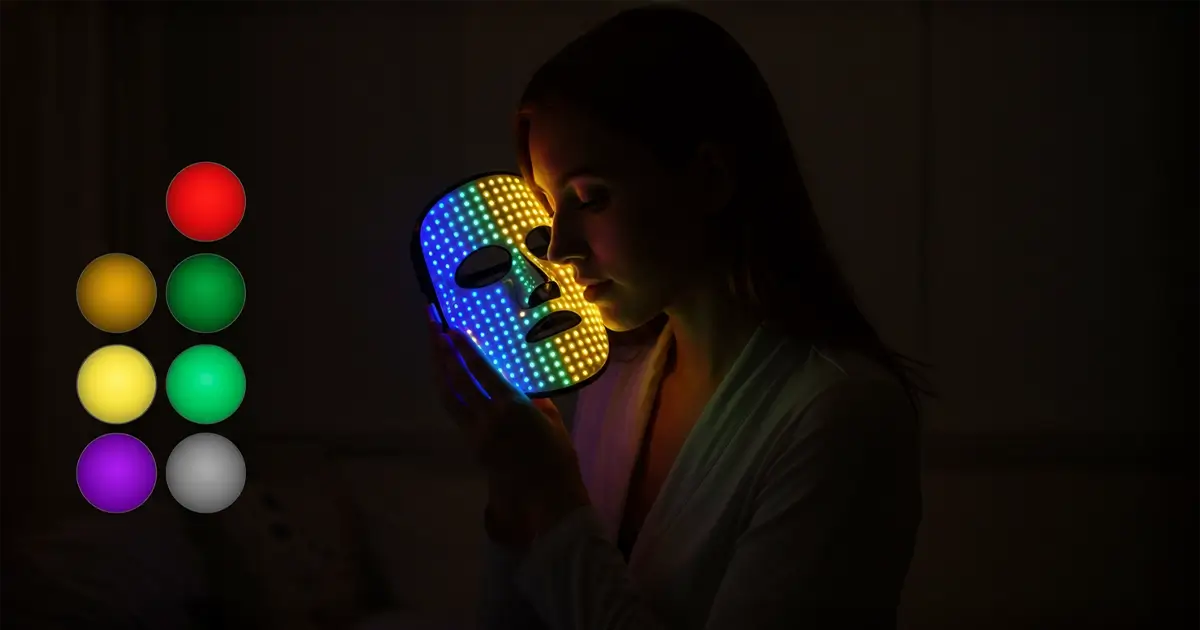Ready to translate the rainbow of LED masks into clear skincare wins? I break down what every glow stick hue actually does, back it up with science, and sprinkle in practical tips you can use tonight.
How LED Light Therapy Works
LED devices give off non-thermal, low-level light that slips through the epidermis and nudges specific molecules, mainly mitochondrial cytochrome c oxidase. When those mitochondria get excited, they speed up ATP production and cell signaling, which in turn can dial down inflammation or switch on collagen-building genes, depending on the color.
Dermatologists call this chain reaction "photobiomodulation." Because energy levels are gentle, there is no tissue damage or burning sensation, only a whisper-soft warmth. That safety profile is why LED panels went from NASA plant experiments to living-room beauty gadgets in just two decades.
Still, not all photons are created equal. Each wavelength has its own travel depth, biological target, and hero capability - think of it like sending different music playlists to various rooms in a house. Grab your metaphorical headphones; here's the color rundown.
Color Guide: Wavelengths and Skin Goals
Before diving into the specifics, remember that millimeters of penetration matter. Shorter wavelengths stay in the epidermis, perfect for surface concerns such as acne, while longer ones cruise toward the dermis, home to collagen and elastin. Let's decode every shade on a typical multi-LED panel.
Numbers in nanometers (nm) below reflect the mid-range most consumer devices emit; hospital-grade tools may fine-tune by ±5 nm.
Red (630–660 nm): Collagen Cheerleader
Red reaches fibroblasts in the upper dermis, urging them to pump out fresh type I and III collagen. This helps soften fine lines, firm lax areas around cheeks or jawline, and calm chronic redness by soothing cytokine activity. This 2025 review found twice-weekly red sessions for eight weeks improved wrinkle depth by up to 18 percent.
Near-Infrared (830–850 nm): Healer in the Wings
Invisible to our eyes yet sensed by deeper dermal cells, near-infrared light accelerates wound repair and eases joint aches. Post-procedure clinics love it for calming laser or microneedling trauma. Because it dives the deepest, it's the wavelength athletes borrow to soothe sore muscles - skin happily piggybacks on that recovery boost.
Blue (410–430 nm): Acne's Nemesis
Blue stops at the upper epidermis, exactly where Cutibacterium acnes hangs out. When blue photons hit those bacteria, endogenous porphyrins release singlet oxygen, essentially popping each microbe like a bubble. Oil glands stay intact, so there is minimal dryness compared to benzoyl peroxide.
Purple (Around 415 nm + 630 nm Blend): Two-Front Attack
Purple panels toggle blue and red in a single pulse sequence. First, blue disinfects pores; then red calms inflammation and prevents post-blemish pigmentation. Busy teens love this combo because it clears spots without the flaky side effects of harsh topicals.
Green (520–535 nm): Melanin Moderator
Green light whispers to melanocytes, toning down tyrosinase activity and dispersing existing clusters of pigment. Shallow penetration makes it ideal for treating sun freckles or stubborn post-acne marks in lighter skin tones. Pair with gentle acids for a tag-team brightening routine.
Yellow/Amber (585–595 nm): Redness Reducer
Hovering between visible and near-infrared, yellow light boosts lymphatic flow and microcirculation. By nudging hemoglobin absorption peaks, it can minimize facial flushing, soften rosacea flares, and speed fade-out of fresh bruises after injectables.
Cyan (500 nm): Calm Hydrator
Cyan sits between green and blue, rolling their benefits into a single mellow glow. Early studies suggest it quiets sebaceous glands without the dryness of purely blue regimens. Users often describe skin feeling "less angry" the next morning.
White/Broad Spectrum Pulse: All-Rounder Booster
Some masks flash multiple LEDs at once, producing white light bursts. Though less researched than individual colors, broad pulses act like circuit training for skin cells: short, varied stimuli keep metabolic pathways responsive and help maintain overall tone.
Safety and At-Home Devices
LED therapy is classed as low-risk, yet sensible habits keep results predictable. Always cleanse skin to remove reflective oils, skip photosensitizing products like high-concentration retinoids right before a session, and pop on opaque goggles if the panel sits inches from your eyes.
Many worry about visible light sneaking in cumulative damage. Good news: LED panels run far below UV intensity, but if you want extra reassurance, see my deep dive on broad-spectrum protection, Is Sunscreen Needed Indoors? UV and Visible Light Facts, for a primer on shielding strategies.
Quick device-choice checklist
- Look for FDA-cleared or CE-marked symbols, which confirm basic safety testing.
- Check irradiance: 30–60 mW/cm² hits the sweet spot for home use without excessive heat.
- Prefer flexible silicone masks for uniform skin contact, especially along the jawline.
- Rechargeable batteries beat cords when you crave couch freedom.
Pro Tips for Brighter Sessions
Think of LED time as a mini mindfulness pause. Play your favorite playlist, set the mask timer, and breathe slowly. Lower cortisol equals better barrier recovery - science and spa vibes in one go. (If you catch yourself humming traffic-light songs while under red and green beams, congratulations, you just found the joke.)
Layering is welcome but strategic. I like a thin, fragrance-free hydrating serum first; it prevents dehydrated patches from reflecting light away. After the beep, seal everything with a peptide cream to hold water in and leverage that freshly energized matrix.
Consistency matters more than marathon sessions. Five quick evenings per week outpace a single Sunday binge because mitochondrial pathways love routine nudges. Set calendar reminders, or prop the mask near your toothbrush so it stares at you with LED puppy-dog eyes.
FAQ
How soon will I see results from red light for wrinkles?
Tiny texture changes can show in four weeks, but most clinical trials mark significant collagen gains at the eight-to-twelve-week mark with three to five sessions weekly.
Can LED light make pigmentation worse?
Blue and red rarely darken spots, yet green or yellow in high doses may temporarily oxidize melanin; stay within manufacturer time limits, and always patch-test if you have melasma.
Is LED safe during pregnancy?
No definitive human studies exist, but because energy levels are non-ionizing and devices don't heat tissue, most obstetricians allow facial use; still, get personal clearance first.
Do I need sunscreen after an evening session?
Night treatments mean UV isn't an issue, but if your mask mixes blue wavelengths that generate free radicals, finish with an antioxidant serum to mop up stray oxygen species.
Will ordinary eyeglasses protect my retinas?
Clear lenses filter only a small portion of visible light, so purpose-made blackout goggles are smarter, especially if your panel sits closer than 10 centimeters.
Conclusion
LED therapy turns a simple palette of colors into targeted skincare actions, from acne control with blue to collagen renewal via near-infrared. Matching wavelength to goal, following safe device habits, and sticking to a steady schedule unlock the technology's full potential.
See you in the next post - until then, take good care of your skin!


Comments (0)
No comments yet - be the first to share your thoughts!
Leave a Reply
Your email address will not be published. Required fields are marked *